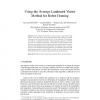Free Online Productivity Tools
i2Speak
i2Symbol
i2OCR
iTex2Img
iWeb2Print
iWeb2Shot
i2Type
iPdf2Split
iPdf2Merge
i2Bopomofo
i2Arabic
i2Style
i2Image
i2PDF
iLatex2Rtf
Sci2ools
CCIA
2007
Springer
2007
Springer
Using the Average Landmark Vector Method for Robot Homing
Several methods can be used for a robot to return to a previously visited position. In our approach we use the average landmark vector method to calculate a homing vector which should point the robot to the destination. This approach was tested in a simulated environment, where panoramic projections of features were used. To evaluate the robustness of the method, several parameters of the simulation were changed such as the length of the walls and the number of features, and also several disturbance factors were added to the simulation such as noise and occlusion. The simulated robot performed really well. Randomly removing 50% of the features resulted in a mean of 85% successful runs. Even adding more than 100% fake features did not have any significant result on the performance. Keywords. Mobile Robot Homing, Average Landmark Vector, Invariant features
| Added | 07 Jun 2010 |
| Updated | 07 Jun 2010 |
| Type | Conference |
| Year | 2007 |
| Where | CCIA |
| Authors | Alex Goldhoorn, Arnau Ramisa, Ramon López de Mántaras, Ricardo Toledo |
Comments (0)

